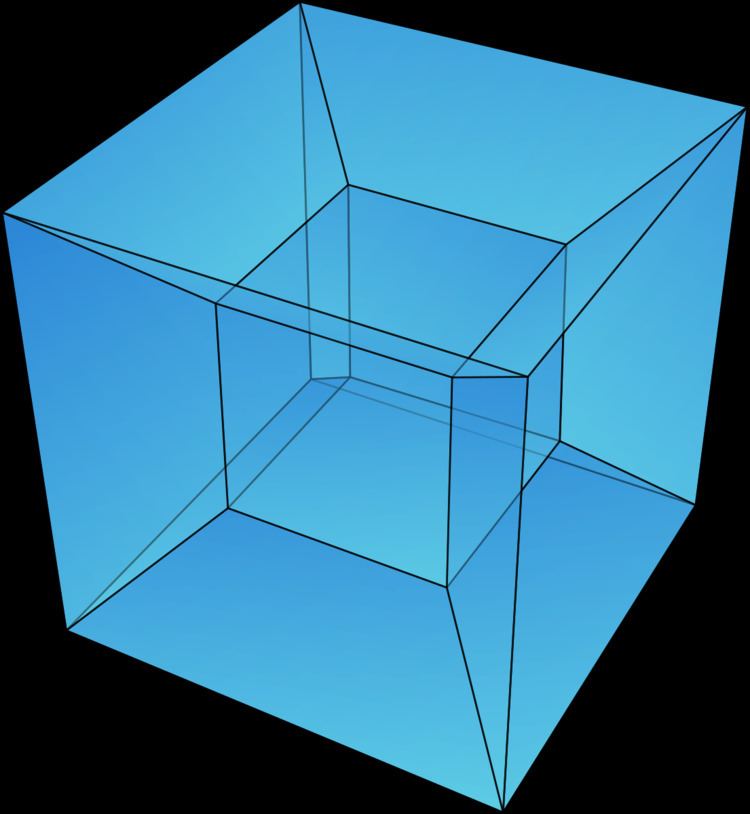 | ||
In mathematics, a regular 4-polytope is a regular four-dimensional polytope. They are the four-dimensional analogs of the regular polyhedra in three dimensions and the regular polygons in two dimensions.
Contents
- History
- Construction
- Regular convex 4 polytopes
- Properties
- Visualization
- Regular star SchlfliHess 4 polytopes
- Names
- Symmetry
- References
Regular 4-polytopes were first described by the Swiss mathematician Ludwig Schläfli in the mid-19th century, although the full set were not discovered until later.
There are six convex and ten star regular 4-polytopes, giving a total of sixteen.
History
The convex regular 4-polytopes were first described by the Swiss mathematician Ludwig Schläfli in the mid-19th century. Schläfli discovered that there are precisely six such figures.
Schläfli also found four of the regular star 4-polytopes; (the grand 120-cell, great stellated 120-cell, grand 600-cell, and great grand stellated 120-cell). He skipped the remaining six because he would not allow forms that failed the Euler characteristic on cells or vertex figures (for zero-hole tori: F − E + V = 2). That excludes cells and vertex figures as {5,5/2}, and {5/2,5}.
Edmund Hess (1843–1903) published the complete list in his 1883 German book Einleitung in die Lehre von der Kugelteilung mit besonderer Berücksichtigung ihrer Anwendung auf die Theorie der Gleichflächigen und der gleicheckigen Polyeder.
Construction
The existence of a regular 4-polytope
to ensure that the cells meet to form a closed 3-surface.
The six convex and ten star polytopes described are the only solutions to these constraints.
There are four nonconvex Schläfli symbols {p,q,r} that have valid cells {p,q} and vertex figures {q,r}, and pass the dihedral test, but fail to produce finite figures: {3,5/2,3}, {4,3,5/2}, {5/2,3,4}, {5/2,3,5/2}.
Regular convex 4-polytopes
The regular convex 4-polytopes are the four-dimensional analogs of the Platonic solids in three dimensions and the convex regular polygons in two dimensions.
Five of them may be thought of as close analogs of the Platonic solids. There is one additional figure, the 24-cell, which has no close three-dimensional equivalent.
Each convex regular 4-polytope is bounded by a set of 3-dimensional cells which are all Platonic solids of the same type and size. These are fitted together along their respective faces in a regular fashion.
Properties
The following tables lists some properties of the six convex regular 4-polytopes. The symmetry groups of these 4-polytopes are all Coxeter groups and given in the notation described in that article. The number following the name of the group is the order of the group.
John Conway advocates the names simplex, orthoplex, tesseract, octaplex or polyoctahedron (pO), dodecaplex or polydodecahedron (pD), and tetraplex or polytetrahedron (pT).
Norman Johnson advocates the names n-cell, or pentachoron, tesseract or octachoron, hexadecachoron, icositetrachoron, hecatonicosachoron (or dodecacontachoron), and hexacosichoron, coining the term polychoron being a 4D analogy to the 3D polyhedron, and 2D polygon, expressed from the Greek roots poly ("many") and choros ("room" or "space").
The Euler characteristic for all 4-polytopes is zero, we have the 4-dimensional analog of Euler's polyhedral formula:
where Nk denotes the number of k-faces in the polytope (a vertex is a 0-face, an edge is a 1-face, etc.).
The topology of any given 4-polytope is defined by its Betti numbers and torsion coefficients.
Visualization
The following table shows some 2-dimensional projections of these 4-polytopes. Various other visualizations can be found in the external links below. The Coxeter-Dynkin diagram graphs are also given below the Schläfli symbol.
Regular star (Schläfli–Hess) 4-polytopes
The Schläfli–Hess 4-polytopes are the complete set of 10 regular self-intersecting star polychora (four-dimensional polytopes). They are named in honor of their discoverers: Ludwig Schläfli and Edmund Hess. Each is represented by a Schläfli symbol {p,q,r} in which one of the numbers is 5/2. They are thus analogous to the regular nonconvex Kepler–Poinsot polyhedra.
Names
Their names given here were given by John Conway, extending Cayley's names for the Kepler–Poinsot polyhedra: along with stellated and great, he adds a grand modifier. Conway offered these operational definitions:
- stellation – replaces edges by longer edges in same lines. (Example: a pentagon stellates into a pentagram)
- greatening – replaces the faces by large ones in same planes. (Example: an icosahedron greatens into a great icosahedron)
- aggrandizement – replaces the cells by large ones in same 3-spaces. (Example: a 600-cell aggrandizes into a grand 600-cell)
John Conway names the 10 forms from 3 regular celled 4-polytopes: pT=polytetrahedron {3,3,5} (a tetrahedral 600-cell), pI=polyicoshedron {3,5,5/2} (an icosahedral 120-cell), and pD=polydodecahedron {5,3,3} (a dodecahedral 120-cell), with prefix modifiers: g, a, and s for great, (ag)grand, and stellated. The final stellation, the great grand stellated polydodecahedron contains them all as gaspD.
Symmetry
All ten polychora have [3,3,5] (H4) hexacosichoric symmetry. They are generated from 6 related Goursat tetrahedra rational-order symmetry groups: [3,5,5/2], [5,5/2,5], [5,3,5/2], [5/2,5,5/2], [5,5/2,3], and [3,3,5/2].
Each group has 2 regular star-polychora, except for two groups which are self-dual, having only one. So there are 4 dual-pairs and 2 self-dual forms among the ten regular star polychora.
Properties
Note:
The cells (polyhedra), their faces (polygons), the polygonal edge figures and polyhedral vertex figures are identified by their Schläfli symbols.
